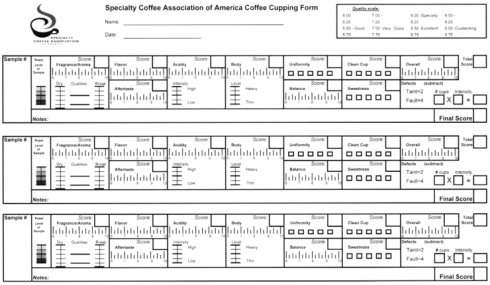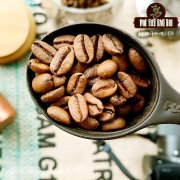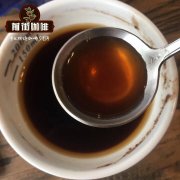Scaa coffee cup meter original picture download SCA coffee cup test procedure standard cup test process

Professional coffee knowledge exchange more coffee bean information please follow the coffee workshop (Wechat official account cafe_style)
What do you need for a cup?
The tools needed for cups are simple: grinders, scales, thermometers, cups, spoons, and the ratio of coffee beans to water are also specified:
Water ratio: 8.25g coffee beans with 150ml water, the water temperature should be 92.2C-94.4C
Cups: toughened glass or ceramic materials should be used
Cups capacity: between 207ml and 266ml
Cup height: 3 to 3.5 inches
Mouth diameter: 76-89mm, all cups should be made of the same volume, size and material, with a lid.
Spoons for cups: use antistatic metal (mostly stainless steel) with a capacity of 4-5ml per spoon.
Cup step
The first step-water injection, soaking: brew and grind all kinds of coffee beans (preferably within 24 hours), grind the coffee to a coarse powder, put the ground coffee powder (particles) into the cup, shake the coffee powder in the cup, smell the dry aroma of the coffee, soak the coffee in the cup according to the ratio of 8.2-8.3 grams of powder to 150ml 94 degrees hot water, let the coffee soak for 3-4 minutes. Until the coffee residue shell is formed.
Step 2-smell Aroma after 2 minutes: wet fragrance is the intensity of the smell when brewing coffee. Some subtle and delicate differences, such as the characteristics of "flower" or "wine", come from the wet aroma of brewing coffee.
Step 3-broken residue: stir three times on the surface of the cup with a spoon, skim off the foam and dregs, and you can start to taste the coffee with a spoon.
Step 4-tasting: remove the coffee scum with a cup spoon, suck the coffee entrance, feel it in the mouth and spit out the coffee liquid, record your feelings on the cup meter, score according to the requirements of the cup meter, gargle, rinse the cup and test the spoon, and then taste the next coffee.
SCA coffee cup discrimination?
SCA Coffee Cup has ten points, of which the following two items are not available in coe:
Fragrance/Aroma aroma: the aroma consists of two parts, dry fragrance and wet fragrance. The first image of the bean grinding and the first project that needs to be scored is the dried fragrance, the aroma of coffee flowers, roasted hazelnuts and roasted almonds are all pleasant aromas. Water injection, the broken shell of the wet fragrance gives people more fantasy, honey, lemon, apricot fruit make people salivating.
Uniformity consistency: this score is relatively simple. Do 5 cups of samples have different tastes and which ones are defective?
The SCA coffee cup meter is marked from 6 points and is divided into four levels:
6 points as "good"
7 points as "very good"
8 points as "excellent"
9 points as "extraordinary".
In addition, each grade is divided into four grades, and the score unit is 0.25 points, so the four levels have a total of 16 points.
Coffee flavor vocabulary
Here are some of the most common coffee flavor words extracted from the flavor wheel. Please mobilize your senses and memory to help you blurt out during the cup test and accurately describe the coffee in front of you.
Flower fragrance | similar to jasmine, rose, daisy, etc.
Fruit aroma | similar to citrus, lemon, apple, BlackBerry and other fruit flavors
Caramel flavor | Candy and syrup flavor
Chocolate flavor | flavor or aroma similar to chocolate
Smell of grass | reminds you of freshly cut grass
The smell of earth / the aroma of moist soil
Malt flavor | similar to the aroma of freshly baked bread
Nutty | an aroma similar to that of fresh nuts
Red wine flavor | an aroma or flavor similar to that of wine
Spice | similar to cloves, cinnamon or other spices
Leather smell | similar to leather taste, belonging to defective flavor
A sharp sour taste | an unpleasant smell
Smell of dust | reminiscent of the smell of an ashtray or fireplace
Sack flavor | Coffee that has been stored for too long, or coffee that has become moldy
Salty | Coffee has a slightly salty taste, caused by prolonged heating
Important Notice :
前街咖啡 FrontStreet Coffee has moved to new addredd:
FrontStreet Coffee Address: 315,Donghua East Road,GuangZhou
Tel:020 38364473
- Prev

Characteristics of Lahu Yami full Red Fruit Solar Coffee in Lancang, Yunnan Province
Professional coffee knowledge exchange more coffee bean information please follow the coffee workshop (Wechat official account cafe_style) Yunnan Lancang producing area Lahu Yami full red fruit sun country: China producing area: Yunnan Lancang bean seed: Katim altitude: 1350 m treatment: sun this batch of coffee from Lancang producing area, produced by Yunnan Aizhe coffee team, planting at 1350 altitude
- Next

Listen to the cup tester to talk about: coffee cup test is what cup test standard, procedure, process, grinding degree
For more information about coffee beans, please follow the coffee workshop (Wechat official account cafe_style) Q. What enables you to turn coffee into a career? In fact, I forgot when I began to think that coffee can be used as a career. I think it was when I read IVE. I started my first job by ordering coffee beans in Fresh. Six or seven years ago, I would bake beans at home.
Related
- Detailed explanation of Jadeite planting Land in Panamanian Jadeite Manor introduction to the grading system of Jadeite competitive bidding, Red bid, Green bid and Rose Summer
- Story of Coffee planting in Brenka region of Costa Rica Stonehenge Manor anaerobic heavy honey treatment of flavor mouth
- What's on the barrel of Blue Mountain Coffee beans?
- Can American coffee also pull flowers? How to use hot American style to pull out a good-looking pattern?
- Can you make a cold extract with coffee beans? What is the right proportion for cold-extracted coffee formula?
- Indonesian PWN Gold Mandrine Coffee Origin Features Flavor How to Chong? Mandolin coffee is American.
- A brief introduction to the flavor characteristics of Brazilian yellow bourbon coffee beans
- What is the effect of different water quality on the flavor of cold-extracted coffee? What kind of water is best for brewing coffee?
- Why do you think of Rose Summer whenever you mention Panamanian coffee?
- Introduction to the characteristics of authentic blue mountain coffee bean producing areas? What is the CIB Coffee Authority in Jamaica?

